Family : Carangidae

Text © Giuseppe Mazza

English translation by Mario Beltramini
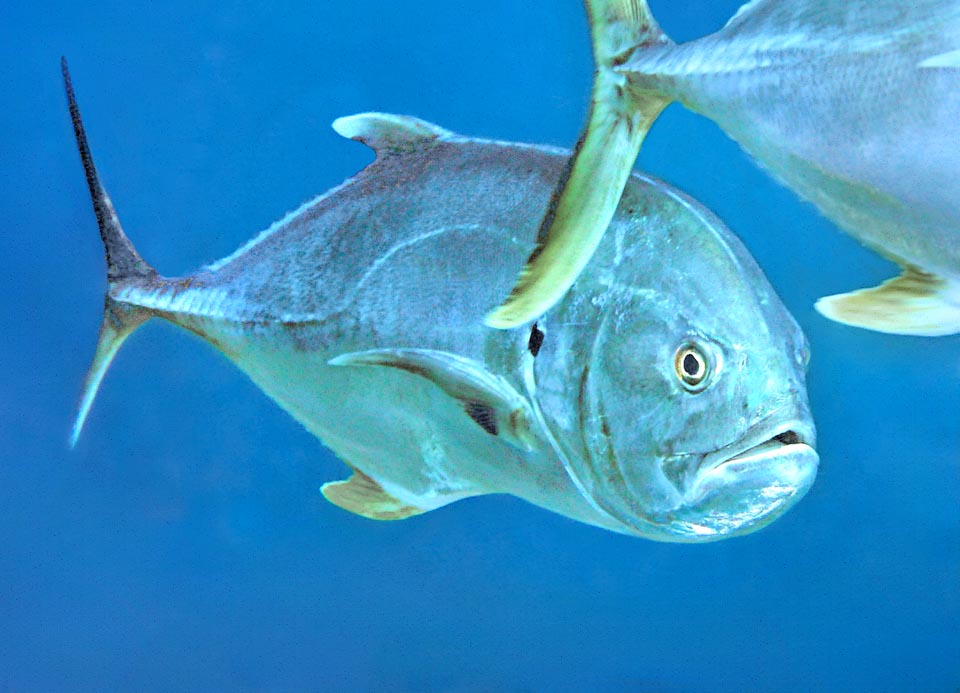
With its equine snout, Crevalle jack (Caranx hippos) lives in tropical and subtropical waters of Atlantic continental shelf, at times entering the Mediterranean © Kevin Bryant
Known as Crevalle jack, Caranx hippos (Linnaeus, 1766), belongs to the class of the Actinopterygii, the ray-finned fishes, to the order of the Perciformes and to the family of the Carangidae that counts about 30 genera and 150 species. Marine fishes, usually with compressed on the sides body, fast swimming predators, common in the tropical waters and present also in the Mediterranean.
The genus Caranx comes from “carangue”, the names that the Antillean French gave to these fishes, whilst the specific term hippos, horse in Greek, refers to the shape of the head that, seen frontally, may lead one to think of an equine.
Zoogeography
Caranx hippos is present in the tropical and subtropical waters of the continental shelf on both sides of the Atlantic. In the Mediterranean has been reported more times, from Nice to Malta, but these are rare sightings.
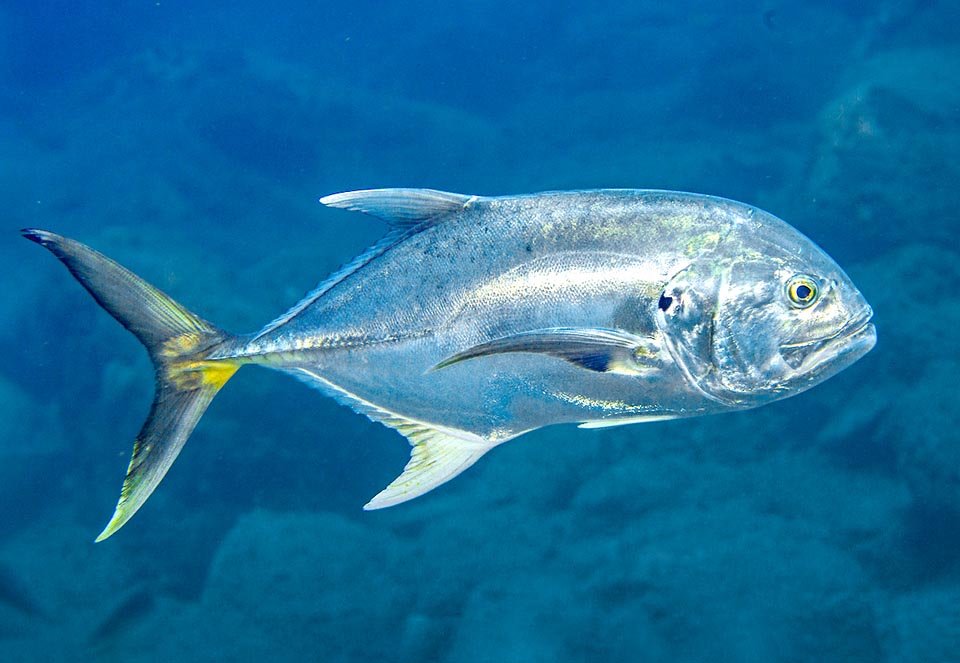
Even 124 cm long, is recognized by three characteristic black spots: on the operculum at the eye level, on the lower rays of the pectoral fins and due to their joint © Allison & Carlos Estape
Ecology-Habitat
It is a fish swimming usually offshore looking for preys, between 1 and 200 m in depth, but also along the coast where it passes in schools over the submerged prairies of phanerogams or the bottoms along beaches, bays, lagoons and madreporic formations. It also accepts brackish waters, going for a while along the course of the rivers, and the juveniles often do grow in the mouths rich in small preys.
Not rarely the oldest specimens go hunting alone and it seems that, while chasing large preys, they go down to over 350 m of depth.
Morphophysiology
The Crevalle jack reaches 124 cm and 32 kg, but the usual length is of about 75 cm and in the Mediterranean even less.
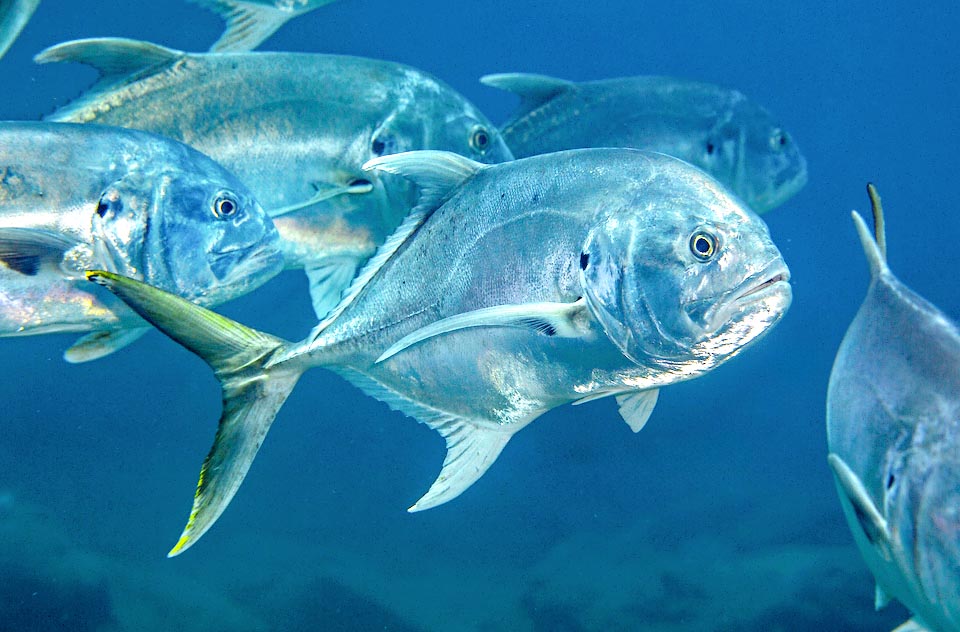
Mostly swims offshore, from 1 to 200 m of depth, but also along the coasts on sandy bottoms, submerged prairies, madreporic formations and river mouths © Allison & Carlos Estape
The body, moderately compressed, has a steep head profile with the jaw articulation aligned below the eye, protected by adipose eyelids.
The mandible, just prominent, has a row of conical teeth, whilst the jaw, with more spaced conical teeth, is sided by a villiform set of teeth present also on the tongue and the palate. The nostrils are minute and the lateral line, with the typical curved trend of the carangids, has in the final straight section 30-34 spiny bont small shields.
There are two dorsal fins: the first, bent while swimming, with 8 spiny rays and the second with one spine followed by 19-22 unarmed rays. The anal displays two spines and after an interruption, well visible only in the juvenile forms because it fades while growing, stands a spiny tray with 16-17 soft rays. The pelvic fins have one spine and 5 unarmed rays. The caudal and the falcate ones, longer than the head, are those typical of a fast fish.
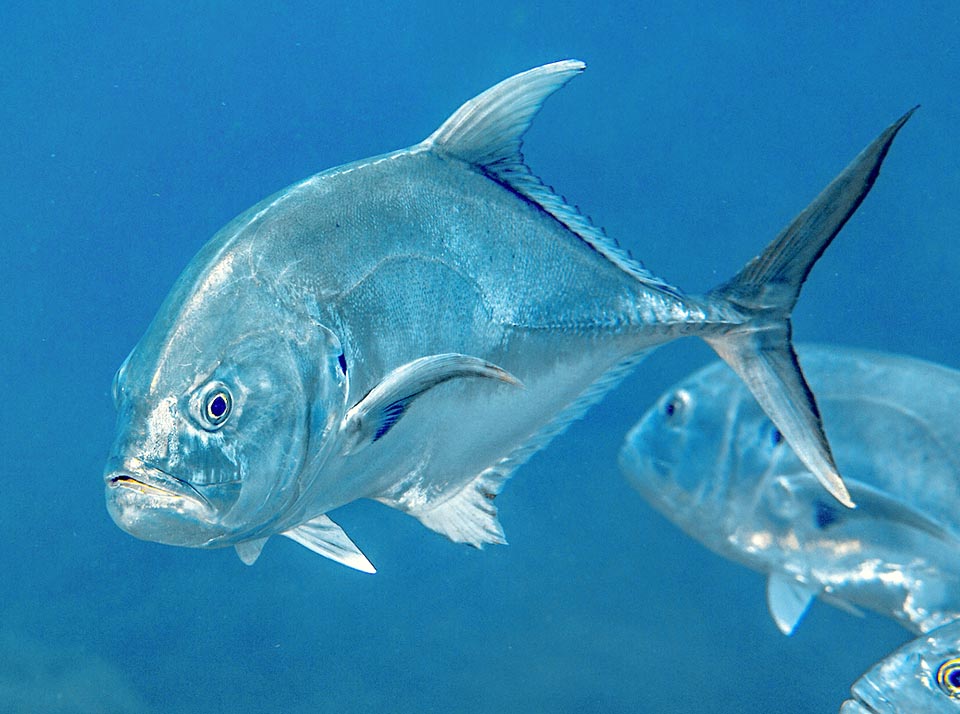
Often hunts small pelagic fishes, like herrings and sardines, but also squids and crustaceans it seizes with quick bursts thanks to its falcate caudal like the big pectorals © Allison & Carlos Estape
The scutes of the Crevalle jack are small and cycloid. They are absent on the thorax, but a small zone in front of the pelvic fins.
The livery, greenish brown on the back, is silvery on the sides. We note 3 characteristic black spots: the first on the operculum at the eye level, the second on the lowest rays of the pectoral fins and the third, smaller, at the axilla of its joint. The caudal fin and sometimes also the lobe of the dorsal and the anal fin, are yellowish, colour more accentuated in the juveniles who show a characteristic mimetic livery with 5 dark vertical bands on the sides.
Ethology-Reproductive Biology
Caranx hippos is a diurnal predator who mainly feeds on small pelagic fishes moving in school like herrings and sardines, but also on squids, shrimps and other crustaceans. The diet varies depending on the sites and it has been noted that the bigger specimens feed opportunist on everything showing up, often sparids and even other species of carangids.
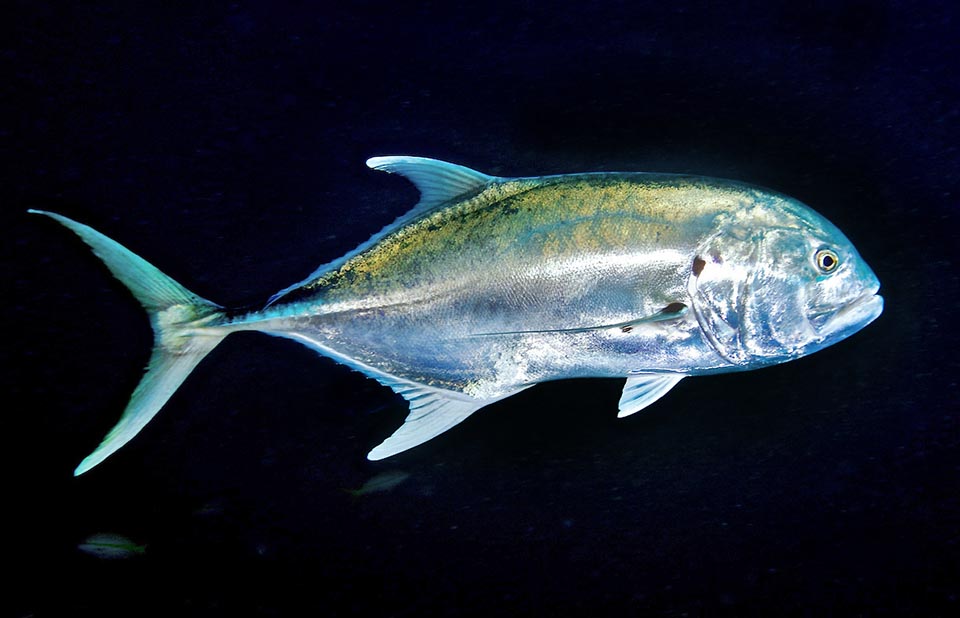
The old adults sometimes live alone but for reproduction take form in suitable sites huge aggregations of schools, with even 1000 individuals, where couples get form © Allison & Carlos Estape
The reproduction occurs all over the year, especially in spring, with peaks in certain locations where they form dense aggregations that may count even 1000 individuals. However, deposition does not happen in mass; couples form, recognizable because one of the two takes on a darker colour for the occasion, that get apart momentarily from the school to spawn and fecundate thousands of pelagic 0,7-0,9 eggs.
Also the larvae, that upon hatching measure 1,6-1,8 mm, are pelagic. Initially they grow hidden under floating objects such as drifting boards or under the huge carpes formed by the sargassoes. Then, at times swimming in the shadow of big fishes, to usually reach the submerged prairies of the estuaries where they grow fast with a life expectancy of 17 years.
The resilience of the species is mediocre with a possible doubling of the populations in 1,4-4,4 years and the fishing vulnerability, moderate, marks 41 on a scale of 100, although it is a widely caught fish with catches, in the world, amounting to almost 40.000 tons per year not to mention the increasing and gratifying sport fishing.
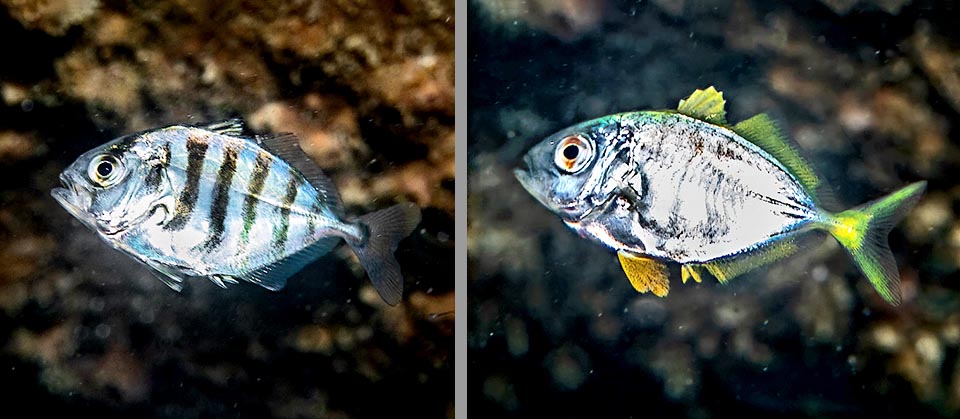
These move aside for spawning thousands of eggs entrusted to the currents. The young have a mimetic livery with 5 dark vertical bands on sides that fade growing © Allison & Carlos Estape
As a matter of fact, when trolled, it proves to be a fighting fish. Sometimes it is able to break the fishing line and when caught emits an intimidating croaking noise, originated by the gnashing of the teeth and amplified by the swim bladder resonance. The flesh, excellent for the Sunday fishermen, is actually mediocre and might be at ciguatera risk if they have preyed upon fishes that store in their diet the toxin produced by the dinoflagellate Gambierdiscus tossico.
Caranx hippos presently appears in the IUCN Red List of the endangered species as “Least Concern”, that is, at “Minimal Worry”.
Synonyms
Scomber hippos Linnaeus, 1766; Carangus hippos (Linnaeus, 1766); Caranx hippos hippos (Linnaeus, 1766); Scomber carangus Bloch, 1793; Caranx carangus (Bloch, 1793); Caranx carangua Lacepède, 1801; Caranx erythrurus Lacepède, 1801; Caranx antilliarum Bennett, 1840; Caranx defensor DeKay, 1842; Trachurus cordyla Gronow, 1854; Carangus esculentus Girard, 1859; Caranx esculentus (Girard, 1859); Caranx hippos caninus Günther, 1867; Caranx hippos tropicus Nichols, 1920.
→ For general information about FISH please click here.
→ For general information about BONY FISH please click here
→ For general information about CARTILAGINOUS FISH please click here.
→ To appreciate the BIODIVERSITY of BONY FISH please click here.
→ To appreciate the BIODIVERSITY of CARTILAGINOUS FISH please click here.
